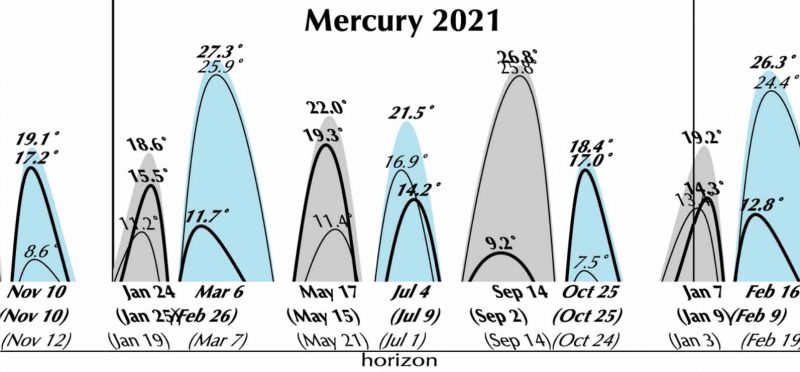
Mercury from Southern Hemisphere
Mercury stages its best evening apparition of this year for the Southern Hemisphere, beginning around the last week of August and through all of September 2021. At southern temperate latitudes, Mercury will stay out until after nightfall (end of evening twilight). Meanwhile, at mid-northern latitudes, Mercury will stay immersed in the afterglow of sunset throughout this same time period. At northerly latitudes, Mercury will be a challenge to catch in the bright evening twilight, even with binoculars.
Nightfall (end of astronomical twilight) comes roughly 1 1/2 hours (90 minutes) after sunset. But the exact duration of evening twilight varies by latitude. The links to the almanacs below provide more specific information.
Times of sunset and end of astronomical twilight via timeanddate.com (worldwide) and Old Farmer’s Almanac (U.S. and Canada)
Folks in the Southern Hemisphere (and the northern tropics) should have little trouble seeing Mercury with the eye alone. Nonetheless, binoculars always come in handy in any Mercury quest.
Mercury reaches its greatest elongation of 27 degrees east of the setting sun on September 14, 2021. At temperate latitudes in the Southern Hemisphere, Mercury will actually stay out for a whopping 3/4 hour (45 minutes) after nightfall. At mid-northern latitudes, on the other hand, Mercury sets about 3/4 hour (45 minutes) after sunset.
Setting time of Mercury in your sky via timeanddate.com (worldwide) and Old Farmer’s Almanac (U.S. and Canada)
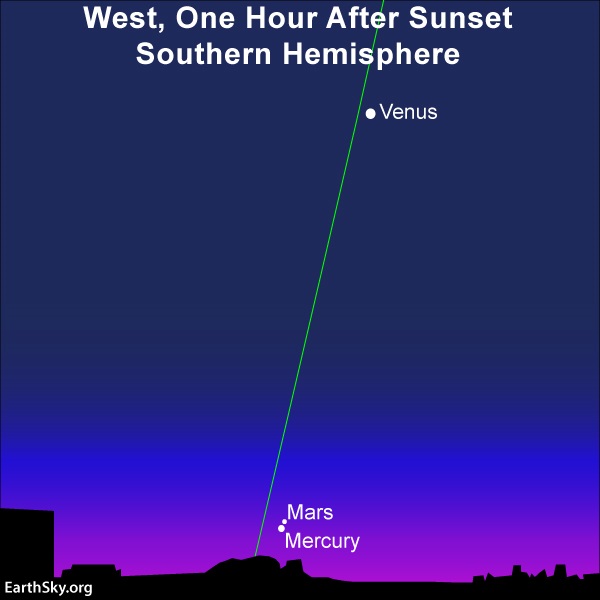
Use Venus to find Mercury
No matter where you live, it’s best to find an unobstructed horizon in the direction of sunset. During an evening apparition, Mercury generally sits low in the west after sundown. Moreover, Mercury usually follows the sun beneath the horizon before it gets good and dark. But this time around, residents of the Southern Hemisphere have the opportunity to catch Mercury in a nighttime sky (after the end of astronomical twilight).
First of all, look for the dazzling planet Venus to pop out at dusk. Then, as dusk deepens into night, use Venus to help guide you to Mercury lurking below. You’ll be looking for Mercury below Venus and above the sunset point on the horizon.
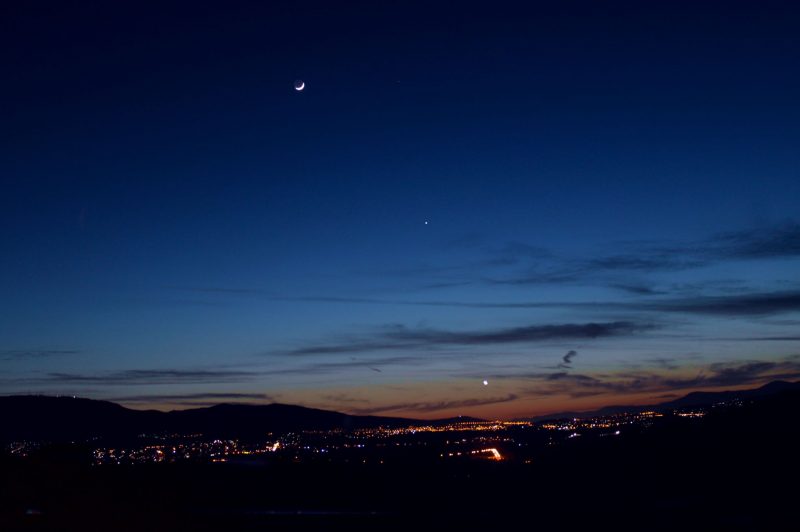
Venus will be the first starlike object to punctuate the evening twilight. Practiced observers might catch Venus as little as 10 to 15 minutes after sunset, or even earlier. Given clear skies, you should be able to see this bright beauty of a planet some 30 to 40 minutes after the sun goes down. After all, Venus ranks as the third-brightest celestial object in all the heavens, after the sun and moon.
Although Mercury pales in contrast to Venus, Mercury is nonetheless no slouch. This world shines on par with a 1st-magnitude star. Mercury may become visible to the eye alone about one hour (60 minutes) after sunset. At mid-northern latitudes, where Mercury doesn’t stay out that long, you will likely need binoculars to spot this elusive world.
Mercury’s greatest evening elongation
We refer you to the illustration below. Mercury, an inferior planet, first entered the evening sky (at superior conjunction) on August 1, 2021. It’ll reach its greatest eastern (evening) elongation on September 14, 2021, and then sweep between the sun and Earth (at inferior conjunction) on October 9, 2021.
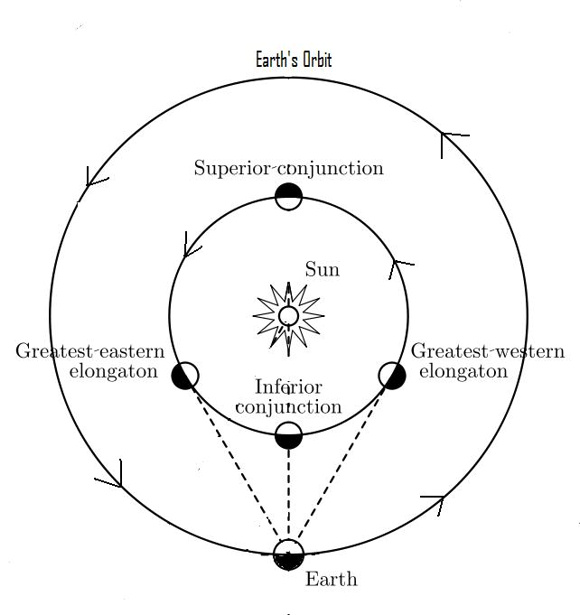
In the diagram above, we’re looking downward at the north side of the solar system. From this vantage point, all the planets orbit the sun counterclockwise. After Mercury laps Earth at inferior conjunction on October 9, it’ll reach its greatest western (morning) elongation on October 25, 2021.
Seasonal advantage smiles on Southern Hemisphere
Far and away, the Southern Hemisphere enjoys the best evening apparition of Mercury for the year. For the Northern Hemisphere, this evening showing of Mercury is the poorest. You might wonder why the stark contrast between the two hemispheres.
Remember this rule. A greatest eastern (evening) elongation of an inferior planet (Mercury and Venus) is most favorable when it happens at or near the spring equinox. Conversely, a greatest eastern (evening) elongation is least favorable around the autumn equinox. This rule applies to both the Northern and Southern Hemispheres.
This year, Mercury’s greatest elongation comes on September 13 or 14, 2021 (depending on time zone). That’s in close vicinity to the September 22 equinox.
The September equinox counts as the Southern Hemisphere’s spring equinox, yet the Northern Hemisphere’s autumn equinox. That’s why the evening apparition of Mercury in August-September 2021 so greatly favors the Southern Hemisphere. If you live in the Southern Hemisphere, take advantage of your golden opportunity. Let your eyes feast upon Mercury at its finest in your evening sky!
Northern and Southern Hemispheres views of Mercury


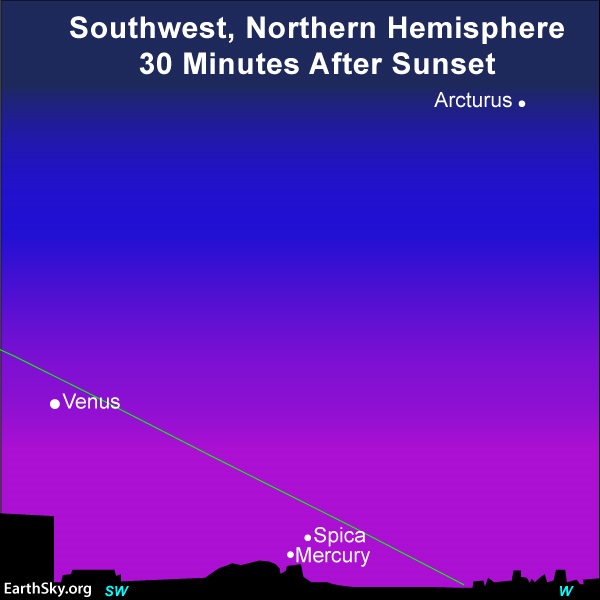

Bottom line: Watch for Mercury from the Southern Hemisphere in late August through September 2021. Meanwhile, from northerly latitudes, bring binoculars!
The post Mercury from Southern Hemisphere, now through September first appeared on EarthSky.
from EarthSky https://ift.tt/3kgfRtg

Mercury from Southern Hemisphere
Mercury stages its best evening apparition of this year for the Southern Hemisphere, beginning around the last week of August and through all of September 2021. At southern temperate latitudes, Mercury will stay out until after nightfall (end of evening twilight). Meanwhile, at mid-northern latitudes, Mercury will stay immersed in the afterglow of sunset throughout this same time period. At northerly latitudes, Mercury will be a challenge to catch in the bright evening twilight, even with binoculars.
Nightfall (end of astronomical twilight) comes roughly 1 1/2 hours (90 minutes) after sunset. But the exact duration of evening twilight varies by latitude. The links to the almanacs below provide more specific information.
Times of sunset and end of astronomical twilight via timeanddate.com (worldwide) and Old Farmer’s Almanac (U.S. and Canada)
Folks in the Southern Hemisphere (and the northern tropics) should have little trouble seeing Mercury with the eye alone. Nonetheless, binoculars always come in handy in any Mercury quest.
Mercury reaches its greatest elongation of 27 degrees east of the setting sun on September 14, 2021. At temperate latitudes in the Southern Hemisphere, Mercury will actually stay out for a whopping 3/4 hour (45 minutes) after nightfall. At mid-northern latitudes, on the other hand, Mercury sets about 3/4 hour (45 minutes) after sunset.
Setting time of Mercury in your sky via timeanddate.com (worldwide) and Old Farmer’s Almanac (U.S. and Canada)

Use Venus to find Mercury
No matter where you live, it’s best to find an unobstructed horizon in the direction of sunset. During an evening apparition, Mercury generally sits low in the west after sundown. Moreover, Mercury usually follows the sun beneath the horizon before it gets good and dark. But this time around, residents of the Southern Hemisphere have the opportunity to catch Mercury in a nighttime sky (after the end of astronomical twilight).
First of all, look for the dazzling planet Venus to pop out at dusk. Then, as dusk deepens into night, use Venus to help guide you to Mercury lurking below. You’ll be looking for Mercury below Venus and above the sunset point on the horizon.

Venus will be the first starlike object to punctuate the evening twilight. Practiced observers might catch Venus as little as 10 to 15 minutes after sunset, or even earlier. Given clear skies, you should be able to see this bright beauty of a planet some 30 to 40 minutes after the sun goes down. After all, Venus ranks as the third-brightest celestial object in all the heavens, after the sun and moon.
Although Mercury pales in contrast to Venus, Mercury is nonetheless no slouch. This world shines on par with a 1st-magnitude star. Mercury may become visible to the eye alone about one hour (60 minutes) after sunset. At mid-northern latitudes, where Mercury doesn’t stay out that long, you will likely need binoculars to spot this elusive world.
Mercury’s greatest evening elongation
We refer you to the illustration below. Mercury, an inferior planet, first entered the evening sky (at superior conjunction) on August 1, 2021. It’ll reach its greatest eastern (evening) elongation on September 14, 2021, and then sweep between the sun and Earth (at inferior conjunction) on October 9, 2021.

In the diagram above, we’re looking downward at the north side of the solar system. From this vantage point, all the planets orbit the sun counterclockwise. After Mercury laps Earth at inferior conjunction on October 9, it’ll reach its greatest western (morning) elongation on October 25, 2021.
Seasonal advantage smiles on Southern Hemisphere
Far and away, the Southern Hemisphere enjoys the best evening apparition of Mercury for the year. For the Northern Hemisphere, this evening showing of Mercury is the poorest. You might wonder why the stark contrast between the two hemispheres.
Remember this rule. A greatest eastern (evening) elongation of an inferior planet (Mercury and Venus) is most favorable when it happens at or near the spring equinox. Conversely, a greatest eastern (evening) elongation is least favorable around the autumn equinox. This rule applies to both the Northern and Southern Hemispheres.
This year, Mercury’s greatest elongation comes on September 13 or 14, 2021 (depending on time zone). That’s in close vicinity to the September 22 equinox.
The September equinox counts as the Southern Hemisphere’s spring equinox, yet the Northern Hemisphere’s autumn equinox. That’s why the evening apparition of Mercury in August-September 2021 so greatly favors the Southern Hemisphere. If you live in the Southern Hemisphere, take advantage of your golden opportunity. Let your eyes feast upon Mercury at its finest in your evening sky!
Northern and Southern Hemispheres views of Mercury




Bottom line: Watch for Mercury from the Southern Hemisphere in late August through September 2021. Meanwhile, from northerly latitudes, bring binoculars!
The post Mercury from Southern Hemisphere, now through September first appeared on EarthSky.
from EarthSky https://ift.tt/3kgfRtg

Aucun commentaire:
Enregistrer un commentaire